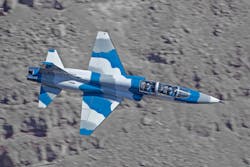Northrop Grumman to flight-test technologies for sensors that cover the entire electromagnetic spectrum
WRIGHT-PATTERSON AFB, Ohio – U.S. Air Force researchers needed a company to flight-test experimental technologies from the Multi-Spectral Sensing Technologies Research and Development (MuSTeR) program to develop RF and electro-optical sensors for offensive, defensive, and integrated offensive and defensive systems. They found their solution from the Northrop Grumman Mission Systems segment in Linthicum, Md.
Officials of the Multispectral Sensing & Detection Division of the Air Force Research Laboratory Sensors Directorate at Wright-Patterson Air Force Base, Ohio, announced a $840,429 contract to Northrop Grumman last week as part of the Multi-Spectral Sensing Technologies R&D (MuSTeR) program.
MuSTeR seeks to enhance the state-of-the-art in U.S. military sensor system research by using the entire electromagnetic spectrum to deliver next-generation capabilities for global persistent awareness.
Related: Northrop Grumman flight tests digital wideband AESA sensor
MuSTeR is developing infrared search and track (IRST) technology, for example, to enable U.S. and allied aircraft to search for airborne targets without giving away their presence by emitting RF and microwave energy.
The project also focuses on improved RF sensing systems for situational awareness and targeting applications, as well as developing an advanced large-format high-dynamic-range long wave infrared (LWIR) digital pixel readout integrated circuit (DPROIC) for airborne infrared and track (IRST) applications.
For this contract Northrop Grumman experts will support test flight of sensor systems. Other MuSTeR contractors are looking into low-cost infrared search and track (LC-IRST) system design tradeoffs, cloud clutter suppression algorithms and processing, and machine learning techniques with the potential to improve overall IRST detection performance.
Related: Raytheon to move hyperspectral sensor program ACES Hy forward with podded flight tests
Northrop Grumman also will provide flight-test support for current and future advancements in large format focal plane arrays, read-out architectures, sensor chip assembly designs, wide-field-of-view optical designs, and advanced processing methods for target detection and tracking at range and in clutter that exploits the high frame rate advantages of a staring system.
Other focus areas of the MuSTeR program for which Northrop Grumman will provide flight support are multiband multifunction radio frequency sensing; laser radar technology; passive radio frequency sensing; and distributed radio frequency sensing.
For more information contact Northrop Grumman Mission Systems online at www.northropgrumman.com, or the Air Force Research Laboratory at www.afrl.af.mil.
About the Author
John Keller
Editor-in-Chief
John Keller is the Editor-in-Chief, Military & Aerospace Electronics Magazine--provides extensive coverage and analysis of enabling electronics and optoelectronic technologies in military, space and commercial aviation applications. John has been a member of the Military & Aerospace Electronics staff since 1989 and chief editor since 1995.
